St Mary’s Church in Wreay, Cumbria is a unique piece of ecclesiastical architecture which is locally, nationally and internationally renowned. Constructed in 1842, it was designed and funded by a local patron named Sarah Losh.
The church is now protected by the Friends Of St Mary’s Church, who contacted our team about a beautiful portrait of Sarah which resides in the building.
 Above: our conservator assessing the portrait whilst on display in the church
Above: our conservator assessing the portrait whilst on display in the church
This oil painting had been passed down from generation to generation and is now protected by the Friends Of St Mary’s Church along with many other artworks and items which are vitally important to its history.
“The portrait of Sarah is important to our church as it’s a piece of its history. We want to tell the story to those who visit. We are custodians of this building and it is important to maintain it.”
– Raymond Whitaker, The Friends Of St. Mary’s Church
 Above: the exterior of St Mary’s Church in Wreay, Cumbria
Above: the exterior of St Mary’s Church in Wreay, Cumbria
Typically, historic churches fluctuate in temperature more rapidly and in higher contrast than a modern building, leading to the constant expansion and contraction of materials. Over time, poor insulation may also lead to a damp or humid atmosphere, which poses high risk to a variety of artworks including oil paintings and works on paper.
Therefore, annual inspections are a helpful way to stay on top of any adverse affects the difficult environment may bring to a church collection. The arrangement of conservation, such as this portrait restoration, is key in preventing wider spread damage occurring to historically important artworks or items.
 Above: the interior of St Mary’s Church in Wreay, Cumbria
Above: the interior of St Mary’s Church in Wreay, Cumbria
Assessing the damage
The portrait of Sarah Losh had been torn in several places over the course of its life and the conditions of the church environment had weakened its structure. Our team assessed the stability of the piece, along with an examination of the surface, using both natural and UV light to find any areas of distortion or historic intervention such as over-painting.
 Above: our easel painting and frame conservator assessing the painting in-situ to make recommendations
Above: our easel painting and frame conservator assessing the painting in-situ to make recommendations
Our conservator’s goal for this painting was to reverse the damage and bring back the original visual impact of the portrait, with minimal intervention. This ensures that the portrait maintains historic and artistic integrity. All proposed treatments for the painting were in keeping with the ethics of our conservators, who only use reversible techniques so that their restoration will never be confused with the original artwork in the future.
 Above: a close-up of the damage on the surface of the portrait which could lead to further deterioration without professional care
Above: a close-up of the damage on the surface of the portrait which could lead to further deterioration without professional care
“The portrait has significance to the church so it’s an important portrait for them and I believe it’s the only portrait of this sitter and that’s an existence… It is an important historical document that needs to be cared for. Hopefully by us conserving it, it’ll last a lot longer for future generations to enjoy.”
– John, Conservator
 Above: our conservators removing the portrait from display in order to carry out the restoration in our studio
Above: our conservators removing the portrait from display in order to carry out the restoration in our studio
Restoring the portrait
Our team of conservators collaborated on this project to ensure the best possible outcome. The lead conservator, Lito, worked alongside John, who has 25 years experience in this conservation field, as well as Wiktor who is a skilled frame technician and conservator.
 Above: our conservator assessing the painting under magnification in our studio
Above: our conservator assessing the painting under magnification in our studio
“The benefit to having a team of conservators on this project is the range of experience and ideas. It’s really good to run ideas past other people with experience. The end product is part of a collaboration with other people who are experts in their own field.”
– Lito, Conservator
 Above: the portrait being assessed under UV light to look for signs of hidden damage and historic over-painting
Above: the portrait being assessed under UV light to look for signs of hidden damage and historic over-painting
Not only did the tears to the canvas make it unstable, the lining of the canvas had also started to come apart. The layers were delaminating due to the environment it had been in for many years, meaning that the painting needed to be fully relined with a new, conservation grade canvas.
 Above: our conservators clearing dust and debris from the back of the canvas and frame (left) and removing the deteriorated lining of the canvas (right)
Above: our conservators clearing dust and debris from the back of the canvas and frame (left) and removing the deteriorated lining of the canvas (right)
The painting underwent a surface clean and varnish removal, this was also important because not only did it remove any historic contamination, but the original varnish had a very high-shine which distracted from the artwork itself due to the strong reflection of light sources. This could now be replaced with a softer finish, which was also UV-protective and non-yellowing.
 Above: the portrait undergoing varnish removal, this is completed with a tailored solution and a handmade cotton swab over many hours
Above: the portrait undergoing varnish removal, this is completed with a tailored solution and a handmade cotton swab over many hours
Areas of unstable paint, especially those around tears, were carefully consolidated and a specialist treatment was used to secure the paint layer. Some areas of the canvas were open to the elements due to the tear, putting them at high risk from exposure. These were filled to level out the surface. The tears underwent a thread-by-thread restoration, before being retouched with exact pigments which are mixed and applied by our skilled conservator.
 Above: the painting being consolidated under tailored pressure on a heated vaccum table in our studio (left) and being placed back onto it’s stretcher bars with new nails and a new lining (right)
Above: the painting being consolidated under tailored pressure on a heated vaccum table in our studio (left) and being placed back onto it’s stretcher bars with new nails and a new lining (right)
“Conservation and restoration is important because we are protecting and safeguarding artworks for the future. A Lot of objects are starting to degrade and to deteriorate from the moment they’re made and they will need some sort of care or conservation as they age. We can’t stop them aging – but we can prolong their life and try to keep them in as good a condition as possible for as long as possible.”
– John, Conservator
 Above: our conservator filling the damaged canvas of the paint layer (left) and retouching the painting with conservation pigments (right)
Above: our conservator filling the damaged canvas of the paint layer (left) and retouching the painting with conservation pigments (right)
The frame was restored alongside the painting so that they could be reunited together in their best conditions. A strong and stable frame will offer further protection to the painting it holds. Our frames conservator Wiktor provided stabilisation treatments, as well as remoulding lost areas and gilding to expertly colour-match the original shade of gold.
 Above: our frame conservator cleaning the frame (left) and remoulding lost areas (right) before reapplying gilding
Above: our frame conservator cleaning the frame (left) and remoulding lost areas (right) before reapplying gilding
The results of the restoration
As always, after the restoration process had taken place our team found it fulfilling to have worked on something with such historical significance, especially in the knowledge that it would now be returned to public display for people to enjoy.
 Above: the portrait of Sarah Losh with restoration complete and a new varnish with a less glossy finish so all of the details are clear
Above: the portrait of Sarah Losh with restoration complete and a new varnish with a less glossy finish so all of the details are clear
The Friends Of St. Mary’s Church were delighted with the result, as now you could see all of the details, including what appears to be a lake district landscape behind her.
 Above: the painting being professionally installed back into place by our team
Above: the painting being professionally installed back into place by our team
The church group was also particularly pleased to see a signature, which they were not aware of before. This clue in the bottom right shows a name which can now be researched by their team.
 Above: a detail of the signature which was discovered on the painting during restoration
Above: a detail of the signature which was discovered on the painting during restoration
To watch a full video on this restoration process, please click here.
Get in touch with our team
If you have any questions related to the restoration of paintings or church collections, including furniture, textiles, and a wider variety of materials, please speak to our friendly team who will be happy to offer advice or arrange an assessment.
You can email [email protected] or calling 0207 112 7576.

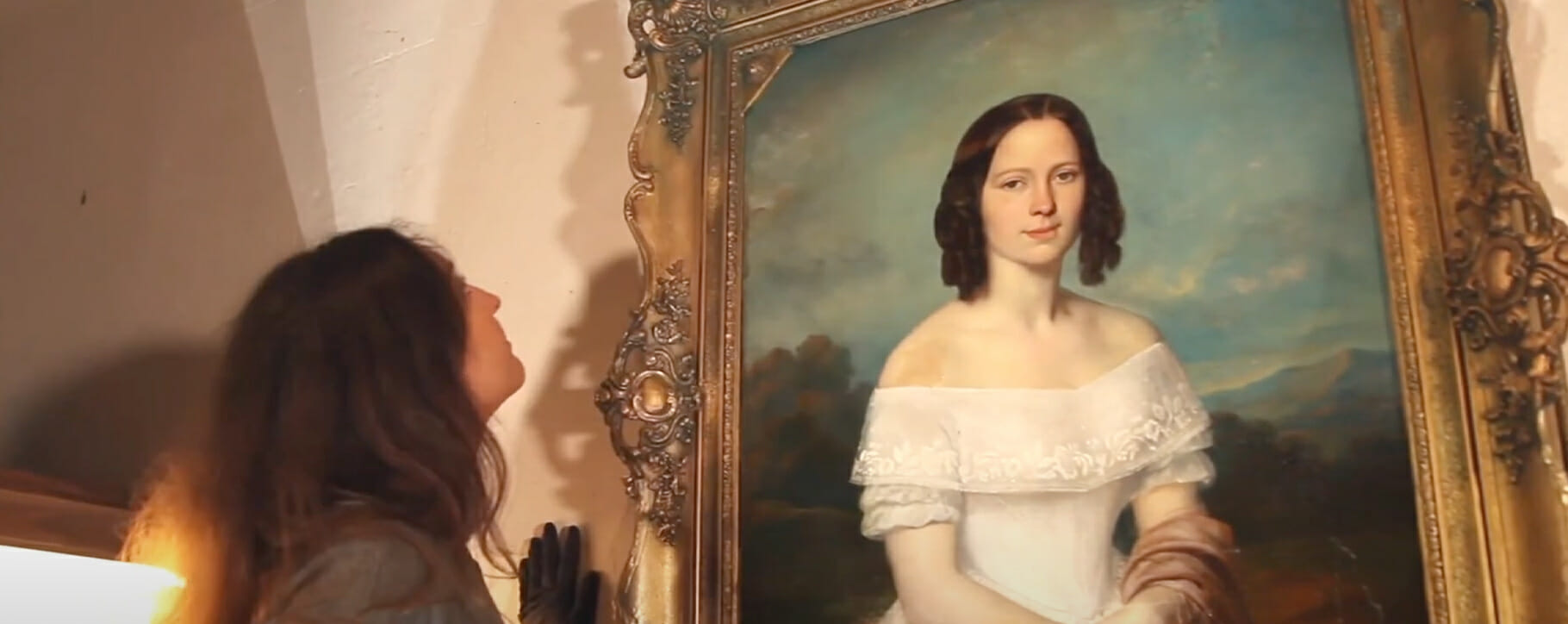 Above: our conservator assessing the portrait whilst on display in the church
Above: our conservator assessing the portrait whilst on display in the church Above: the exterior of St Mary’s Church in Wreay, Cumbria
Above: the exterior of St Mary’s Church in Wreay, Cumbria Above: the interior of St Mary’s Church in Wreay, Cumbria
Above: the interior of St Mary’s Church in Wreay, Cumbria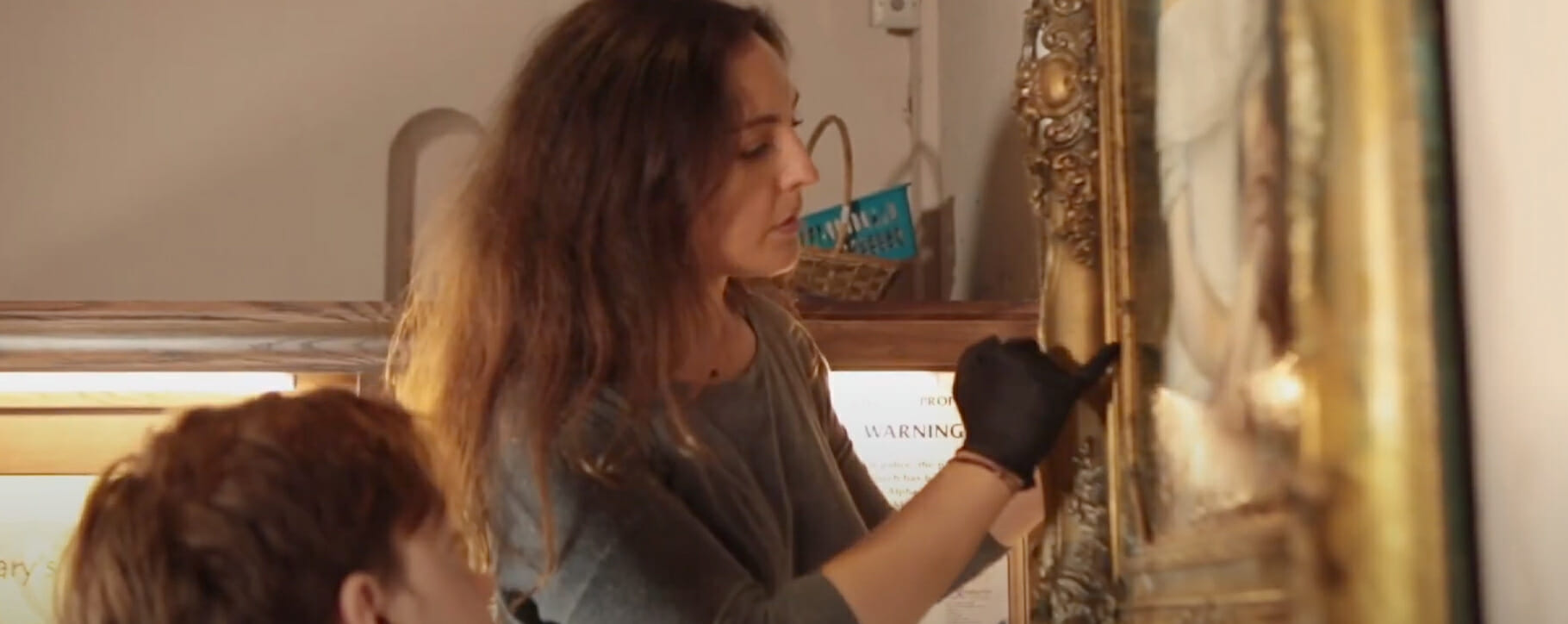 Above: our easel painting and frame conservator assessing the painting in-situ to make recommendations
Above: our easel painting and frame conservator assessing the painting in-situ to make recommendations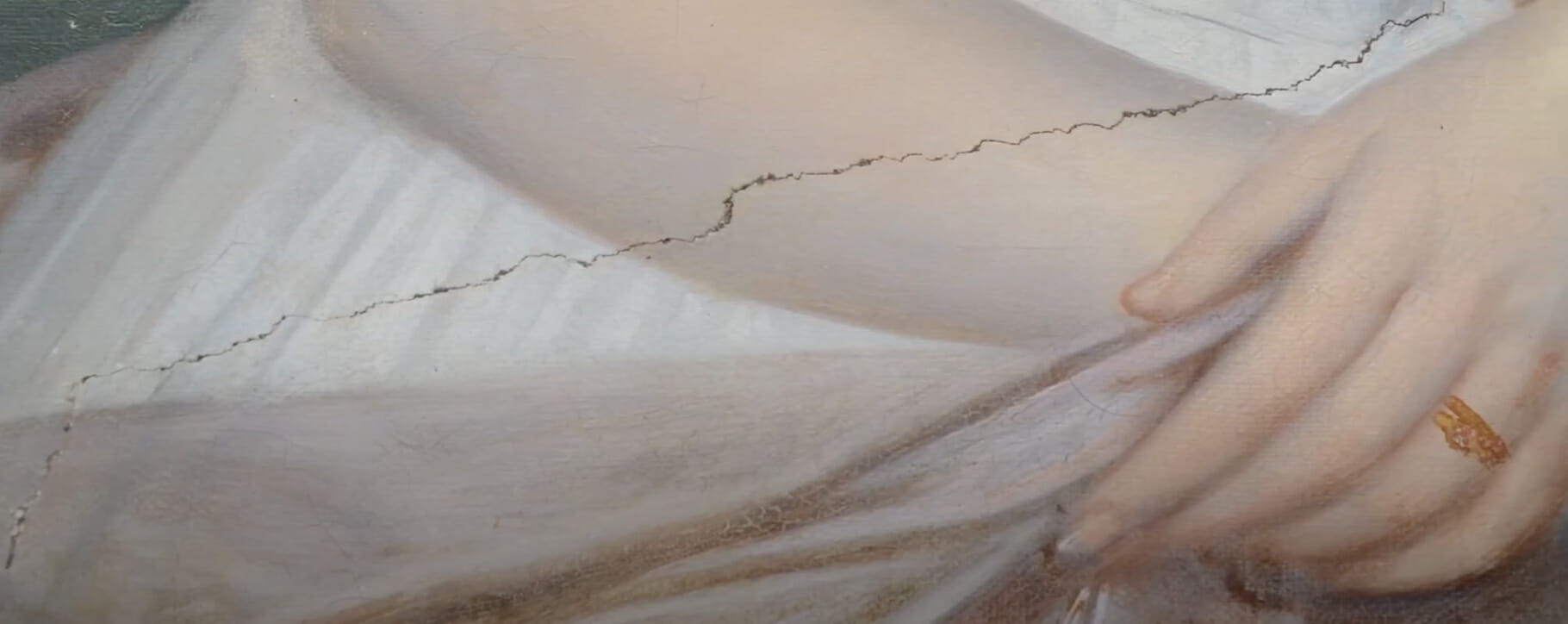 Above: a close-up of the damage on the surface of the portrait which could lead to further deterioration without professional care
Above: a close-up of the damage on the surface of the portrait which could lead to further deterioration without professional care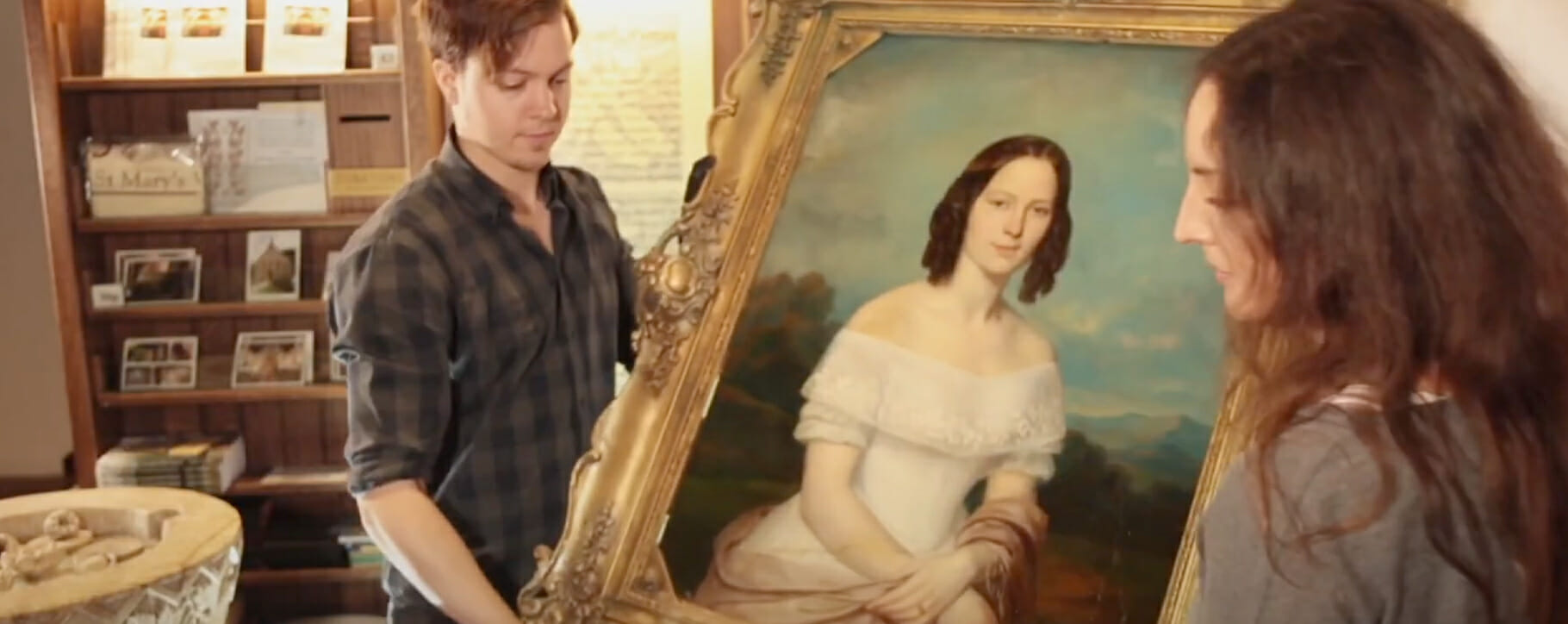 Above: our conservators removing the portrait from display in order to carry out the restoration in our studio
Above: our conservators removing the portrait from display in order to carry out the restoration in our studio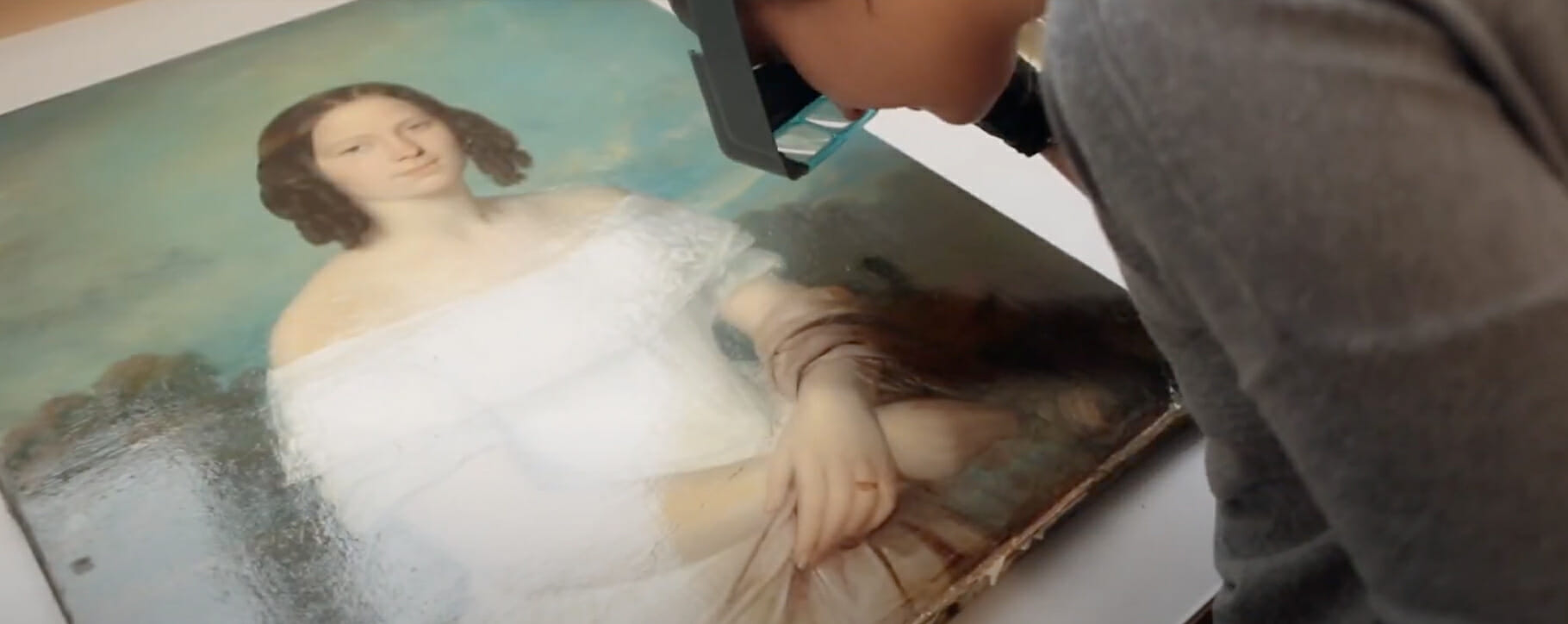 Above: our conservator assessing the painting under magnification in our studio
Above: our conservator assessing the painting under magnification in our studio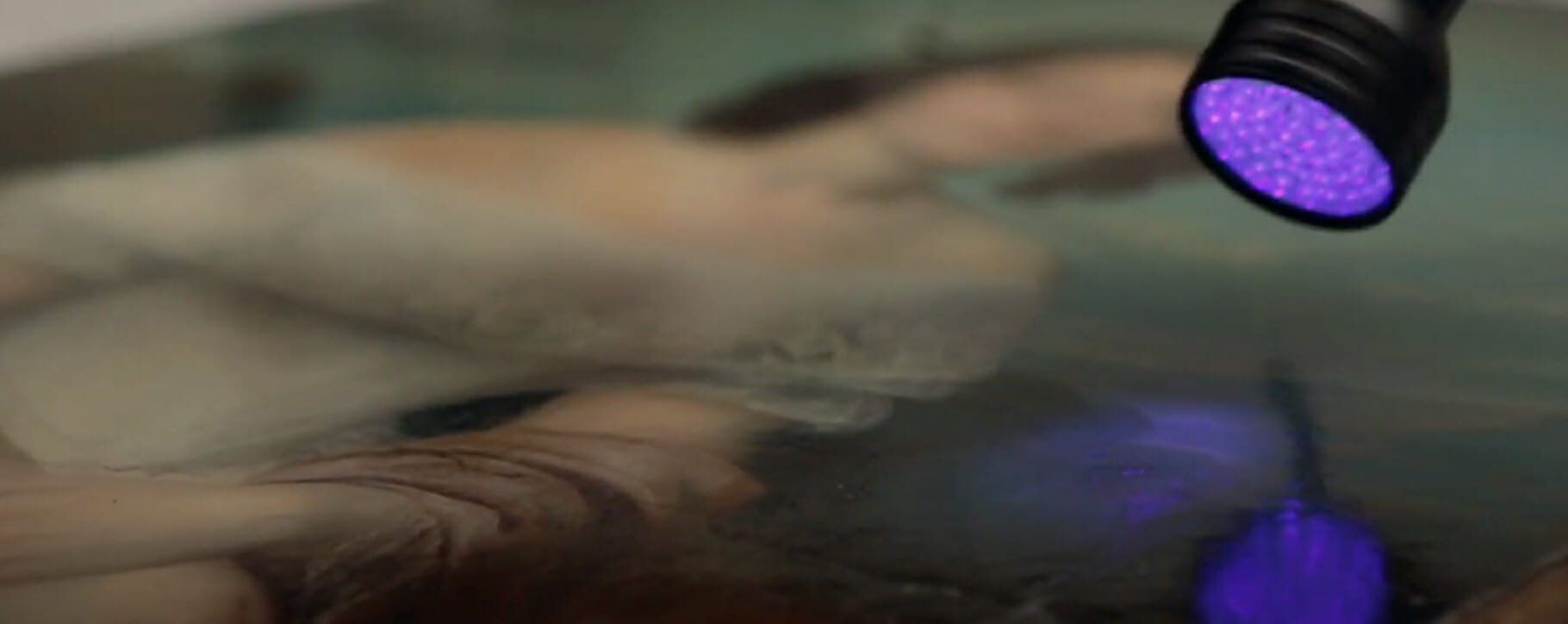 Above: the portrait being assessed under UV light to look for signs of hidden damage and historic over-painting
Above: the portrait being assessed under UV light to look for signs of hidden damage and historic over-painting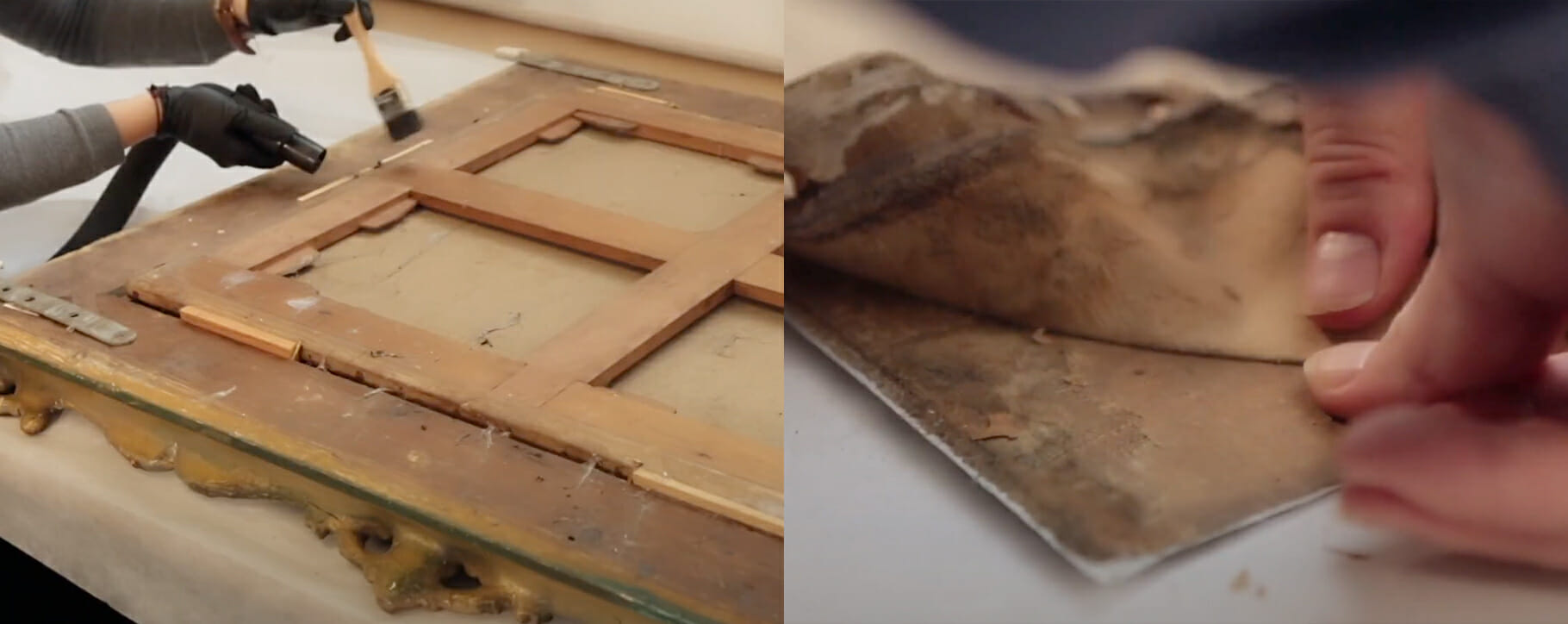 Above: our conservators clearing dust and debris from the back of the canvas and frame (left) and removing the deteriorated lining of the canvas (right)
Above: our conservators clearing dust and debris from the back of the canvas and frame (left) and removing the deteriorated lining of the canvas (right) Above: the portrait undergoing varnish removal, this is completed with a tailored solution and a handmade cotton swab over many hours
Above: the portrait undergoing varnish removal, this is completed with a tailored solution and a handmade cotton swab over many hours Above: the painting being consolidated under tailored pressure on a heated vaccum table in our studio (left) and being placed back onto it’s stretcher bars with new nails and a new lining (right)
Above: the painting being consolidated under tailored pressure on a heated vaccum table in our studio (left) and being placed back onto it’s stretcher bars with new nails and a new lining (right)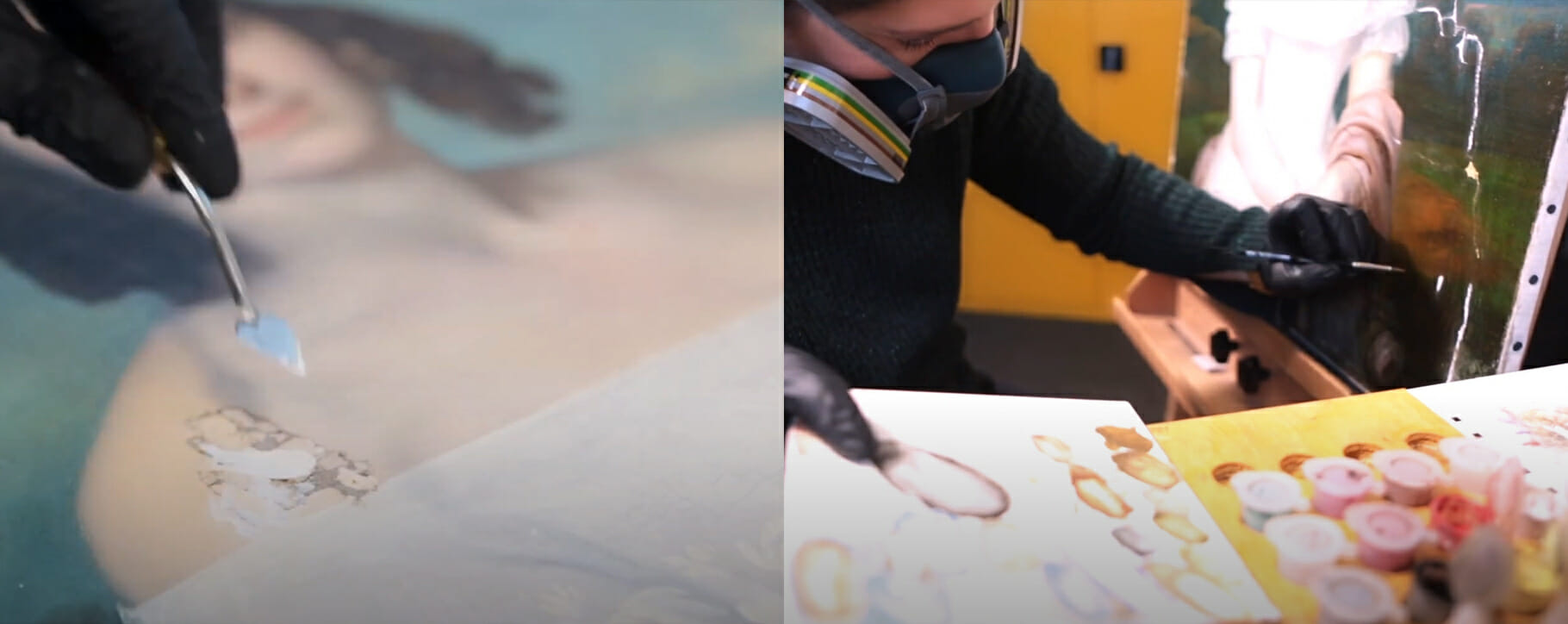 Above: our conservator filling the damaged canvas of the paint layer (left) and retouching the painting with conservation pigments (right)
Above: our conservator filling the damaged canvas of the paint layer (left) and retouching the painting with conservation pigments (right)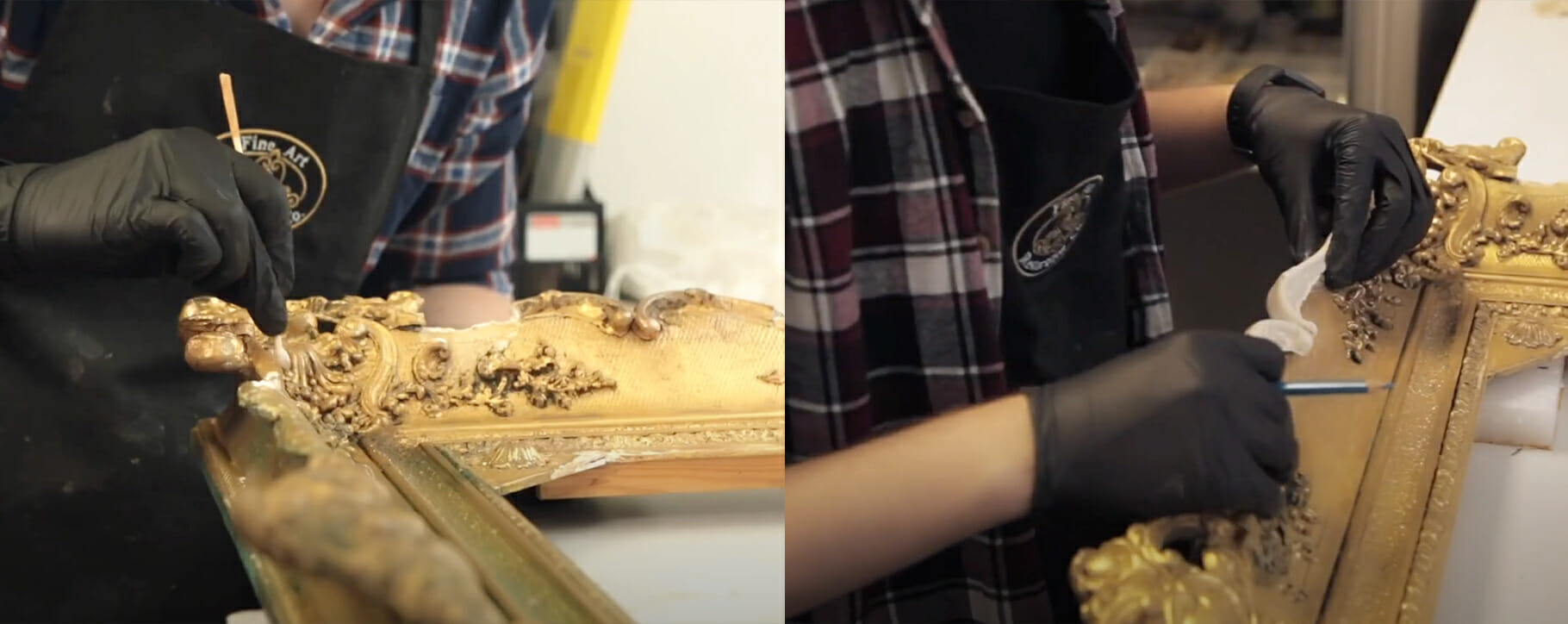 Above: our frame conservator cleaning the frame (left) and remoulding lost areas (right) before reapplying gilding
Above: our frame conservator cleaning the frame (left) and remoulding lost areas (right) before reapplying gilding  Above: the portrait of Sarah Losh with restoration complete and a new varnish with a less glossy finish so all of the details are clear
Above: the portrait of Sarah Losh with restoration complete and a new varnish with a less glossy finish so all of the details are clear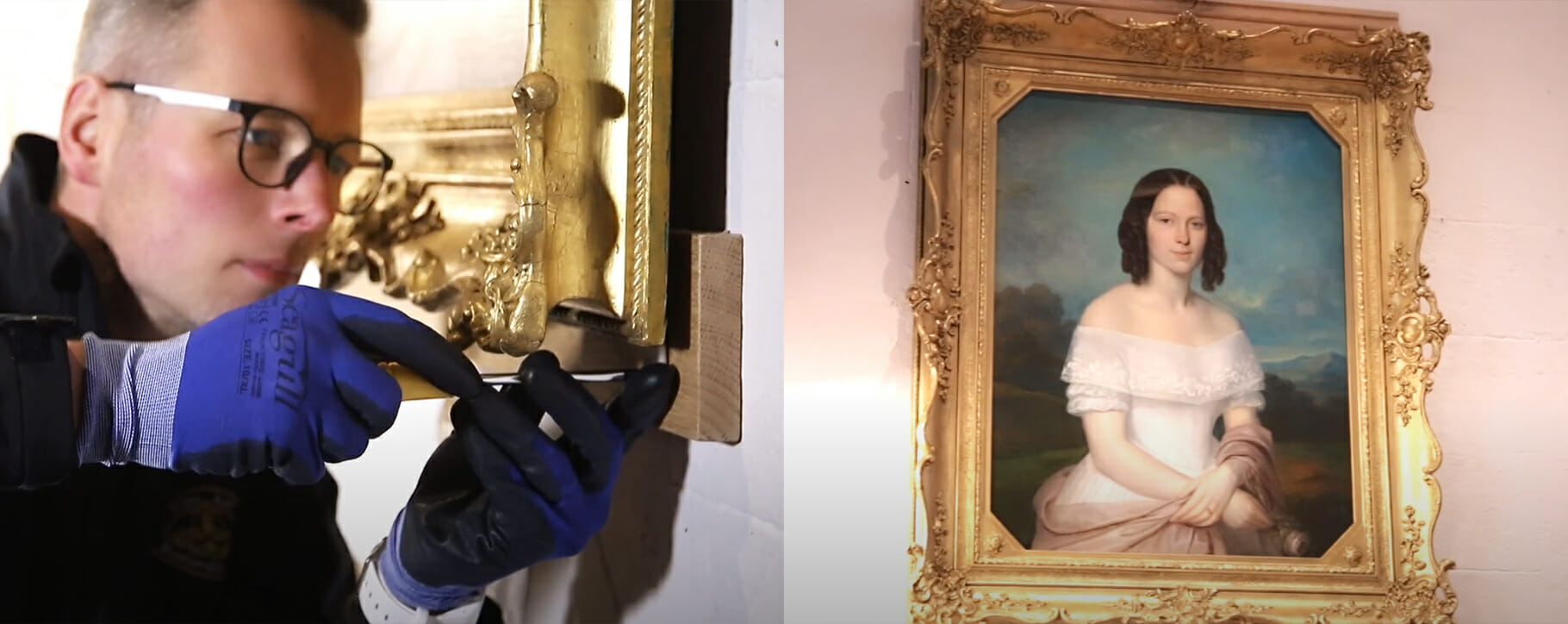 Above: the painting being professionally installed back into place by our team
Above: the painting being professionally installed back into place by our team Above: a detail of the signature which was discovered on the painting during restoration
Above: a detail of the signature which was discovered on the painting during restoration




